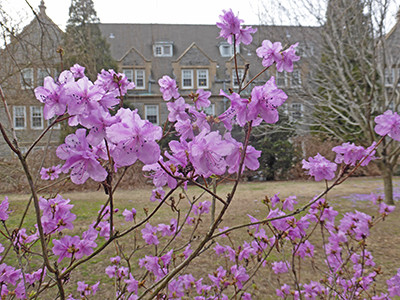
Plants of the Week: February 27
Rhododendron mucronulatum, native to Korea, Japan, and Northern China, is considered to be one of the earliest flowering deciduous rhododendrons. Typically blooming in mid-March to early April, the variety is currently in full bloom along the path between Sproul Observatory and Wharton Hall.
The cultivar ‘Cornell Pink’ boasts clear, pure pink flowers. Plants prefer sun-dappled shade in a location protected from strong winter winds. Avoid warm sunny southern exposures where plants may flower/leaf out too early and suffer frost damage. Good soil drainage is essential as “wet feet” often lead to root rot and inevitable decline and death. Photo credit: J. Coceano
Parrotia persica is a beautiful utilitarian tree. Its growth habit, reaching 20’-40’ at maturity, makes it ideal for smaller gardens. Exfoliating bark and reliable fall color add to its appeal.
While not flashy in size, form, or color, the apetulous flowers are alluring upon closer inspection. Dense red stamens surrounded by a brownish bract appear in abundance before the leaves emerge. While likely to be overlooked at other times of the year, the flowers are most welcome when the garden is just beginning to stir. Photo credit: J. Coceano
Edgeworthia chrysantha ‘Snow Cream’ is a Plant Delights Nursery introduction. The nursery has written this about the ever-popular shrub: “This stunning member of the daphne family is one of our most prized plants in the garden. All summer, the 8′ tall x 8′ wide umbrella-shaped clump, supported by a smooth brown trunk, is adorned with plumeria-like leaves. The foliage drops in mid-December to reveal both the wonderful bark and the large, silvery flower buds. The flower buds open steadily from mid-January to early April, producing an overwhelmingly fragrant display of pendent, golden yellow flowers.
Edgeworthia chrysantha is more winter hardy (below 0 degrees F) than Edgeworthia papyrifera and much easier to grow. In 2007 we finally named the clone we selected for large foliage and flowers and sold without a cultivar name for over a decade.” A young plant can be seen in the Terry Shane Teaching Garden. Photo credit: J. Coceano








No Comments